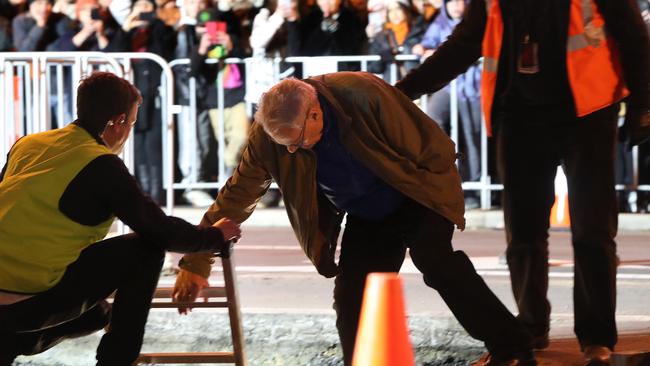Reflecting on our dark past
Well done to the Dark Mofo festival’s creative director Leigh Carmichael for giving performance artist Mike Parr another bizarre stage to challenge us on this year.

Opinion
Don't miss out on the headlines from Opinion. Followed categories will be added to My News.
WELL done to the Dark Mofo festival’s creative director Leigh Carmichael for giving performance artist Mike Parr another bizarre stage to challenge us on this year. Parr’s three days buried in a glorified shipping container underneath our busiest street — with no way for any of us to view the performance/installation — might not immediately feel like art but this was, after all, a Dark Mofo show. Pushing boundaries and challenging the audience by forcing us to think is what David Walsh’s Mona brand is built on. The Mofo festival is an extension of that.
And there’s no denying Walsh — and Carmichael — are on to something. Gone are the days of Hobart hibernating in mid-winter, of restaurants shut and city streets empty. Instead, through the Dark Mofo festival Hobartians have learned to embrace our short, cold days — and so have mainlanders.
The festival’s two big weekends have become among the busiest across the entire year in our city in terms of interstate visitors. The “quirky, inimitable, very cool” attributes of our New Tasmania that Premier Will Hodgman has started to spruik when on the mainland are a direct spin-off of the Walsh brand, and Dark Mofo certainly lives up to that pitch.
It was not so surprising, then, that the climax of Parr’s performance on Sunday night was anything but traditional. Climbing out of his temporary tomb, the 73-year-old simply shook the hands of two onlookers and then wandered off — failing to even acknowledge the crowd who had gathered in the cold and rain to watch. But in some ways the genius of his hurried exit is that it forces reflection. And that was the point of this entire expensive exercise.
Parr’s performance — Underneath the Bitumen the Artist — was sold as an acknowledgment of the dark history that sits just under the surface of Tasmania: the transportation of 75,000 British and Irish convicts to our island in the 19th century, and the subsequent destruction of the state’s indigenous population.
We have said before in this column that we should all be much more willing to openly acknowledge what happened on this island in the not-too-distant past. As individuals we were of course not responsible, but as Tasmanians we do share a collective responsibility for ensuring the suffering is never forgotten.
We have come a long way in recent decades in acknowledging our convict past. At the same time we have made great strides in recognising our island’s indigenous heritage. But we still have work to do when it comes to properly recognising the appalling post-colonial treatment of the First Tasmanians. After generations of sweeping the truth under the carpet, it’s time we started talking about it much more openly.
Perhaps that’s why Hobartians were so willing to allow Parr’s performance to go ahead — because it goes to the core of our island’s darkest secret. It’s a secret that is a constant no matter how much we change as a state; it’s there, ever-present just below the surface of the busy, mechanised and technologically advanced 21st century life that we all lead.
As cartoonist Christopher Downes drew yesterday, to the question “If we can’t see it, is it art?” comes the reply: “If we don’t talk about it, is it history?”


